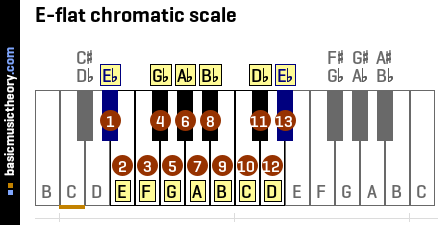Chromatic scale
| Key | C | C# | Db | D | D# | Eb | E | F | F# | Gb | G | G# | Ab | A | A# | Bb | B |
|---|
1 octave - 12 notes
Chromatic scales contain 12 notes, and include every note including the starting tonic note highlighted as the first blue note below. All white and black keys are used.
The 13th note (also in blue) is the same note name as the tonic note, but is 1 octave higher, and has twice the frequency of note 1.
So note 1 - E-flat above middle C has a frequency of 329.63 Hz, and note 13 is (2 x 329.63) = 659.26 Hz.
The next E-flat (which would be shown as note 26) has twice the frequency again - 1318.51, and so on.

The Eb chromatic scale shows the E-flat chromatic scale above.
Chromatic scale naming in the context of a key signature
If chromatic scale notes are being used and identified within the context of a scale with a key signature (eg. major scale, or any minor scale), then the key signature will be the guide as to whether to use sharps or flats for the chromatic scale.
For example, if a sharp-based key signature is used, eg. G major key signature, and we want to use the chromatic scale to identify notes outside that scale, sharps would be used for those chromatic scale notes.
The same principle applies to flat-based key signatures, eg. Eb major key signature, where flat note names would be used.
Chromatic scales without a key signature
For both C major key signature and A natural minor key signature, there are no sharp or flat notes, so since there is no key signature, we have no clue as to whether to use sharp or flat names to identify any non-natural notes.
Although there seem to be no generally agreed rules on how to handle this, one common music theory convention is to use sharps when ascending the scale ie. when playing the notes from lowest to the highest pitch, then use flats when descending.